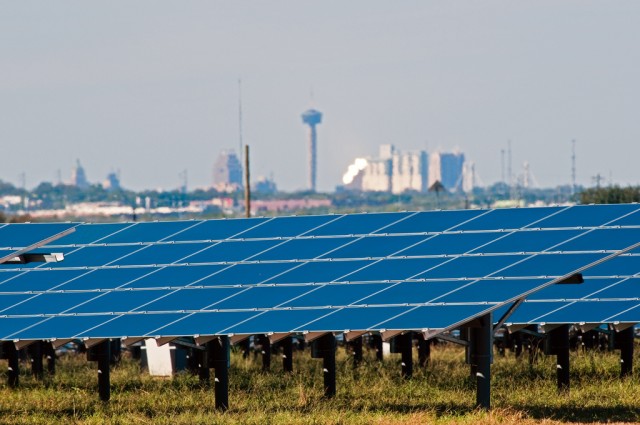Through sun, wind and earth, the U.S. Army Installation Management Command is finding ways to make installations run smoother, smarter and with less resources.
Staff of the Headquarters IMCOM G-3/5/7 Plans Directorate visited San Antonio\'s 14-megawatt Blue Wing Solar Project on April 7 to better understand how to operationalize sustainability and see how renewable energy is being integrated into the local community.
The Blue Wing Solar Project is operated by a privately owned utility company that sells the energy to the city-owned CPS Energy. All of the renewable power generated by the site's 214,500 solar panels serves customers of CPS Energy.
The project sits on what used to be a cornfield on the southeast side of San Antonio. It is now the largest working solar farm in Texas and one of the biggest in the United States. The 140-acre site generates enough energy to power 1,800 homes, emissions-free.
"Essentially what we're attempting to do is get to Net Zero," said Steven Carpenter, lead program manager for IMCOM G-3/5/7 strategic plans division. "This visit helps us understand how to implement current sustainability concept for providing alternative energy sources and learn what's going on in the local community. We want to learn how we can adapt those business practices into installation management."
Through renewable energy resources and modernized infrastructure, installations will improve the security of the sources of their energy and water and sustain the environment long-term. Reducing dependency on fossil fuels, the national power grid, reducing water consumption and preserving natural resources directly supports Army Force Generation, according to the 2010 Quadrennial Defense Review Report.
"Unleashing warfighters from the tether of fuel and reducing our installations' dependence on a costly and potentially fragile power grid will not simply enhance the environment, it will significantly improve our mission effectiveness," said Dr. Dorothy Robyn, Ph.D. deputy under secretary of defense installations and environment.
The Installation Management Community Campaign Plan, or IMCP, directs IMCOM to manage resources, conserve and secure energy, operate, and build future capabilities to achieve the Army's Triple Bottom Line of Mission, Community and Environment. The IMCP also directs the command to integrate the application of sustainability principles into daily operations and to assume a "sustainability mindset" in all aspects of its operations.
The Army has a total of 66 energy security projects on CONUS that generate 353 million British thermal units of renewable energy. Ft. Knox uses a geothermal heat pump to provide cooling and heating throughout the year, and Ft. Carson, Ft. Huachuca and Ft. Drum draw energy from photovoltaic solar arrays. Ft. Bliss is testing geothermal wells, Ft. Sill is exploring its micro-grid field capability and Ft. Jackson is developing a fuel cell project.
"We learned you can't put all your eggs in one basket - you need several sources of energy, including wind, solar and geothermal, to get to net zero," Carpenter said. "But solar is an important component. Our ultimate goal is to be self-sustaining through renewable energy."




Social Sharing